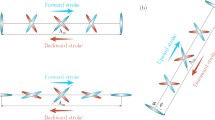Abstract
To develop autonomous flapping aircraft, basic mathematical modeling is essential to solve the problem of “uncertainty models” in biomimetic flight dynamics. This study identified the longitudinal linear model of an ornithopter via automated flight tests and sensors onboard the ornithopter to measure angular rates, Euler angles, and total velocity. For accurate flight tests, automated signal input was designed for elevator deflection: doublet and multistep 3211 maneuver. Furthermore, because the flapping motion of the ornithopter’s main wings generates oscillations during cruise flight, fast Fourier transform is used to analyze flight data in the frequency domain, and a Butterworth filter is used to filter out the flapping motion from the data. The characteristics of the actuator are then analyzed using a motion capture camera and applied to the system identification. The structure of the ornithopter linear model is found to be similar to that of a fixed-wing aircraft, which has a periodic oscillation. The results from the flight tests and analysis manifest that an ornithopter has unstable characteristics due to a single right-half plane real pole.



















Similar content being viewed by others
References
Kim D, Han J (2007) An aerodynamic model of flapping-wing aircraft using modified strip theory. In: The Korean Society for aeronautical and space sciences 2007 fall conference, 2007, pp 25–28
Armanini SF, de Visser CC, De Croon GC (2015) Black-box LTI modelling of flapping-wing micro aerial vehicle dynamics. In: AIAA conference, 2015
Armanini SF, de Visser CC, De Croon GCHE, Mulder M (2016) Time-varying model identification of flapping-wing vehicle dynamics using flight data. J Guidance Control Dyn 39(3):526–541
Caetano JV, De Visser CC, De Croon GCHE, Remes B, De Wagter C, Verboom J, Mulder M (2013) Linear aerodynamic model identification of a flapping wing MAV based on flight test data. Int J Micro Air Veh 5(4):273–286
Lee JS, Kim JK, Kim DK, Han JH (2011) Longitudinal flight dynamics of bioinspired ornithopter considering fluid-structure interaction. J Guidance Control Dyn 34(3):667–677
Lee JS, Kim HY, Han JH (2013) Control of tailed flapping-wing flying robot. In: Proceedings of the 10th international conference on ubiquitous robots and ambient intelligence, 2013
Ryu S, Jin Kim H (2014) Altitude control of a flapping wing micro air vehicle. In: The Korean Society for aeronautical and space sciences 2014 fall conference, 2014, pp 357–360
Grauer J, Ulrich E, Hubbard JE, Pines D, Humbert JS (2011) Testing and system identification of an ornithopter in longitudinal flight. J Aircr 48(2):660–667
Gim H, Kim S, Suk J, Cho S (2016) Longitudinal system identification of ornithopter with automated flight tests. IFAC-PapersOnLine 49(17):194–199
Morelli EA (1997) Flight test validation of optimal input design and comparison to conventional inputs. In: AIAA atmospheric flight mechanics conference, 1997, pp 11–13
Lee YS, Suk JY, Kim TS (2002) A flight test method for the system identification of an unmanned aerial vehicle. J Korean Soc Aeronaut Space Sci 30(7):130–136
Nelson RC (1998) Flight stability and automatic control. WCB/McGraw Hill, New York
Sj J, Zhang Q, Ljung L, Benveniste A, Delyon B, Glorennec PY, Hjalmarsson H, Juditsky A (1995) Nonlinear black-box modeling in system identification: a unified overview. Automatica 31(12):1691–1724
Koo S, Lee D, Kim K, Ra CG, Kim S, Suk J (2014) Guidance and control system design for automatic carrier landing of a UAV. J Inst Control Robot Syst 20(11):1085–1091
Tatebe O (1993) The multigrid preconditioned conjugate gradient method. In: Proceedings of the 6th Copper Mountain conference on multigrid methods, Copper Mountain, CO, 1993
Oh G, Park C, Kim M, Park J, Kim Y (2012) Small UAV system identification in time domain. In: Proceedings of the spring Conference of KSAS, vol 1113, 2012
Acknowledgements
This research was supported by a Grant to Bio-Mimetic Robot Research Center funded by Defense Acquisition Program Administration, and by Agency for Defense Development (UD130070ID). In addition, this study was partly supported by National Research Foundation in Republic of Korea (Contract no. NRF-2015R1C1A1A02036862), and the Ministry of Trade, Industry and Energy (MOTIE) of Korea, Republic (Contract no. 10062327).
Author information
Authors and Affiliations
Corresponding author
Rights and permissions
About this article
Cite this article
Gim, H., Lee, B., Huh, J. et al. Longitudinal System Identification of an Avian-Type UAV Considering Characteristics of Actuator. Int. J. Aeronaut. Space Sci. 19, 1017–1026 (2018). https://doi.org/10.1007/s42405-018-0084-5
Received:
Revised:
Accepted:
Published:
Issue Date:
DOI: https://doi.org/10.1007/s42405-018-0084-5




